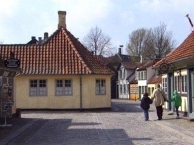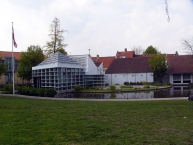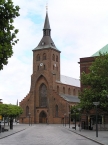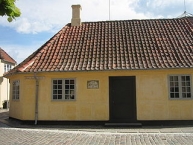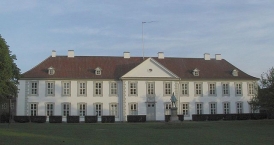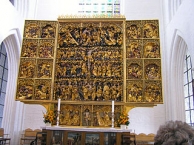Cycle Tour Odense-Hamburg
Travel report: Fyn-Sønderjylland-Slesvig-Holsten
Actions
![]()
Please wait - map data are loading
Added on 31 Mar 2014,
last edited by Ottocolor on 08 May 2014
Actions
Cycle route metrics
planned
ridden
Total distance in km
231
313
Cumulative elevation gain in m
1.591
1.853
Avg. slope uphill in %
0,69
0,59
Cumulative elevation loss in m
1.592
1.833
Information about rights to the gps-track data | |
|---|---|
Rights owner | |
Rights characteristic / license | by-sa: CREATIVE COMMONS Attribution-ShareAlike |
Link to the description of the license | |
GPX file uploaded | by Ottocolor on 23 Apr 2014
|
Track points in total
2.111
4.146
Track points per km (avg)
7
13
Start/endpoint
Start location
Odense, Region Syddanmark, DK (11 m NHN)
End location
Hamburg, Hamburg, DE (10 m NHN)
Character
Three-day cycle tour from Odense (Naesby) to Hamburg. Planned to be ridden April 28th to 30th 2014. First day Odense-Flensburg via ferry Boejden-Fynshav, Ulkeboel and Soenderborg. Accomodation at Flensbed in Flensburg. Second day Flensburg-Neumuenster via Missunde and Rendsborg. Train from Neumuenster to Hamburg. Accomodation at Buch-ein-Bett in Hamburg St. Pauli. Third day round trip in Hamburg with a visit to the lost property office at Altona station along the river Elbe to the ship welcoming site at Schulau, a ferry cross the Elbe, through the blooming apple plantations of "Altes Land" and back to Hamburg through Finkenwerder and the harbour (ferry cross the Koehlbrand and through the old tunnel under the Elbe), through the harbour city with a look at the scandalous building site of the Elbe philharmony and shopping at Globetrotter. Train back to Odense in the evening. Arrival at 23.15.
Information about copyright | |
|---|---|
Rights characteristic / license | by-sa: CREATIVE COMMONS Attribution-ShareAlike |
Link to the description of the license | |
taken over / edited on | 31 Mar 2014 - 25 Apr 2014
|
taken over / edited by |
|
Stages
Information about copyright | |
|---|---|
Rights owner | |
Rights characteristic / license | by-sa: CREATIVE COMMONS Attribution-ShareAlike |
Link to the description of the license | |
Image has been uploaded | by Ottocolor on 04 May 2014
|
112 km
Odense-Flensburg
Information about copyright | |
|---|---|
Rights owner | |
Rights characteristic / license | by-sa: CREATIVE COMMONS Attribution-ShareAlike |
Link to the description of the license | |
Image has been uploaded | by Ottocolor on 04 May 2014
|
126 km
Flensburg-Neumünster-Hamburg
Information about copyright | |
|---|---|
Rights owner | |
Rights characteristic / license | by-sa: CREATIVE COMMONS Attribution-ShareAlike |
Link to the description of the license | |
Image has been uploaded | by Ottocolor on 08 May 2014
|
75 km
Hamburg
Beds4Cyclists, worth visiting and infrastructure
Name and address
Latitude / Longitude
Phone
Fax
Mobile
Type of accommodation
Rating for cyclists
Route km
Dist. to route
Elevation
2 km
2,2 km
15 m
Information about copyright | |
|---|---|
Rights owner | Hansjorn at da.wikipedia |
Rights characteristic / license | by-sa: CREATIVE COMMONS Attribution-ShareAlike |
Link to the description of the license | |
Image taken over from | |
Image has been uploaded | by Ottocolor on 06 Apr 2013
|
Information about copyright | |
|---|---|
Rights owner | Fingalo |
Rights characteristic / license | by-sa: CREATIVE COMMONS Attribution-ShareAlike |
Link to the description of the license | |
Image taken over from | |
Image has been uploaded | by Ottocolor on 06 Apr 2013
|
H. C. Andersens Hus ist die dänische Bezeichnung für das Haus, in dem der dänische Dichter Hans Christian Andersen wahrscheinlich geboren wurde. Das Haus liegt in der Altstadt von Odense in der „Bangs Boder“ Straße.
Obwohl der Geburtsort von Andersen nicht mit Sicherheit ermittelt werden kann, ist es wahrscheinlich, dass er in dem Haus geboren wurde. In diesem Haus wohnte die Großmutter von Andersen und 1805, als der spätere Dichter geboren wurde, wohnte die Tante von Andersen dort. Sie war die einzige Verwandte von Andersens Eltern, die in der Region wohnte. Andersen lebte auf jedem Fall nicht lange in dem Haus. Seine Kindheit verbrachte er in einem Haus in der Munke Møllestræde. Dort wurde 1930 das Museum „H.C. Andersens Barndomshjem “ errichtet.
1905, 100 Jahre nach der Geburt von Andersen, beschloss die Stadt Odense, ein Museum im wahrscheinlichen Geburtshaus des Dichters zu errichten. Die Stadt restaurierte das Haus und eröffnete das Museum 1908 am Geburtstag des Dichters.
2005 wurde das Museum erweitert. Es besteht aus einem Neubau. In diesem wird anhand zahlreicher Dokumente das Leben und das Werk des Dichters dargestellt. Der alte Teil des Museums ist das eigentliche Geburtshaus. Dies ist so eingerichtet, wie es 1805 wahrscheinlich ausgesehen hat.
Information about copyright | |
|---|---|
Rights characteristic / license | by-sa: CREATIVE COMMONS Attribution-ShareAlike |
Link to the description of the license | |
Input taken over from: |
Seite „H. C. Andersens Hus“. In: Wikipedia, Die freie Enzyklopädie. Bearbeitungsstand: 1. April 2013, 08:52 UTC. URL: http://de.wikipedia.org/w/index.php?title=H._C._Andersens_Hus&oldid=116459742 (Abgerufen: 6. April 2013, 20:47 UTC) |
taken over / edited on | 06 Apr 2013
|
taken over / edited by |
|
Hours of opening
1. Januar - 30. Juni, Dienstag bis Sonntag 10 - 16 Uhr
1. Juli - 1. September, Montag bis Sonntag 10 - 17 Uhr
2. September - 31. Dezember, Dienstag bis Sonntag 10 - 16 Uhr
Geöffnet am 2. Ostertag und 2. Pfingsttag sowie montags in den Wochen 7, 8, 13 und 42.
Geschlossen am 24, 25. und 31. Dezember sowie am 1. Januar.
2 km
2,1 km
13 m
Information about copyright | |
|---|---|
Rights owner | VisitOdense |
Rights characteristic / license | © all rights reserved. |
Image has been uploaded | by Ottocolor on 20 Mar 2013
|
Hours of opening
02/01/2013 - 30/06/2013Monday - Friday09:30 - 16:3002/01/2013 - 30/06/2013Saturday10:00 - 13:0001/07/2013 - 31/08/2013Monday - Friday09:30 - 18:0001/07/2013 - 31/08/2013Saturday10:00 - 15:0001/07/2013 - 31/08/2013Sunday11:00 - 14:0001/09/2013 - 30/06/2014Monday - Friday09:30 - 16:3001/09/2013 - 30/06/2014Saturday10:00 - 13:00
2 km
2,1 km
13 m
Information about copyright | |
|---|---|
Rights owner | LWich |
Rights characteristic / license | by-sa: CREATIVE COMMONS Attribution-ShareAlike |
Link to the description of the license | |
Image taken over from | commons.wikimedia.org/wiki/File:Odense_-_Sankt_Knuds_kirke_2005-07-16.jpeg |
Image has been uploaded | by Ottocolor on 20 Mar 2013
|
Information about copyright | |
|---|---|
Rights owner | Niels Elgaard Larsen |
Rights characteristic / license | by-sa: CREATIVE COMMONS Attribution-ShareAlike |
Link to the description of the license | |
Image taken over from | |
Image has been uploaded | by Ottocolor on 20 Mar 2013
|
Information about copyright | |
|---|---|
Rights owner | Kåre Thor Olsen |
Rights characteristic / license | by-sa: CREATIVE COMMONS Attribution-ShareAlike |
Link to the description of the license | |
Image taken over from | |
Image has been uploaded | by Ottocolor on 20 Mar 2013
|
Information about copyright | |
|---|---|
Rights owner | Gunnar Bach Pedersen |
Rights characteristic / license | by-sa: CREATIVE COMMONS Attribution-ShareAlike |
Link to the description of the license | |
Image taken over from | |
Image has been uploaded | by Ottocolor on 20 Mar 2013
|
Odense (Danish pronunciation: [ˈoðˀn̩sə]) is the third largest city in Denmark. It has a population of 168,798 (as of 1 January 2012) and is the main city of the island of Funen . The city is the seat of Odense Municipality, with a population of 191,610 (as of 1 January 2012), and was the seat of Odense County until 1970, and Funen County from 1970 until 1 January 2007, when Funen County became part of the Region of Southern Denmark.
Tourist attractions
Saint Canute's Cathedral (Danish: Sankt Knuds Kirke) was formerly connected with the great Benedictine monastery of the same name, and is one of the largest and finest buildings of its kind in Denmark. It is constructed of brick in a pure Gothic style. Originally dating from 1081–1093, it was rebuilt in the 13th century. Under the altar lies Canute
(Danish: Knud), the patron saint of Denmark, who had planned to conquer England, then ruled by William of Normandy
. Canute was slain in an insurrection at Odense in 1086. Odense is also the see of the bishop of Funen. The cathedral has the skeletons of both the Saint/King and his brother on public display. A large fragment of Byzantine
cloth is displayed next to the two skeletons. The cathedral also boasts one of Denmark's finest altarpieces, a magnificent triptych
by Claus Berg
. Kings John
(Danish: Hans) and Christian II
are buried in the city.
Our Lady's Church, built in the 13th century and restored in 1851–1852 and again in 1864, contains a carved 16th century altarpiece by Claus Berg of Lübeck
.
Odense Palace was erected by King Frederick IV , who died there in 1730.
There is a theatre as well as a symphony orchestra, a zoo, and the Funen Village (Den Fynske Landsby) which is an open-air museum with old houses typical of Funen.
The City Hall has a small scar from a battle between Germans and members of the Danish Resistance on 5 May 1945. The city's coat of arms – located above the main entrance to City Hall – is damaged. On closer inspection, it can be seen that the kneecap of Saint Canute was penetrated by a bullet.
The 4 most visited attractions in 2007 were:
1. Odense Zoo – 420,254 visitors
2. The Funen Village – 105,040 visitors
3. Danish Railway museum – 97,759 visitors
4. H.C. Andersen's House – 80,622 visitors
Other attractions:
- Odense City Museums
- Hans Christian Andersen Museum
- Hans Christian Andersen's House
- The Funen Village
- Odense Theatre
- Odense Fjord
- Churches & Cathedrals
- Saint Knud's Cathedral
- Saint Albani Church
- Vor Frue Church
- Saint Hans Church
- Saint Knud's Cathedral
- Odense Zoo
- Odense Central Library
- Odense Sportspark
- University of Southern Denmark
previously known as Odense University
- Odense Symphony Orchestra
- Odense Music School
- Danish Railway Museum
- Nonnebakken
- Teater Momentum
- Galschiøt Art Workshop, founday and Exhibition
Information about copyright | |
|---|---|
Rights characteristic / license | by-sa: CREATIVE COMMONS Attribution-ShareAlike |
Link to the description of the license | |
Input taken over from: |
Wikipedia contributors, 'Odense', Wikipedia, The Free Encyclopedia, 13 February 2021, 20:01 UTC, |
taken over / edited on | 20 Mar 2013
|
taken over / edited by |
|
2 km
2,0 km
26 m
2 km
1,7 km
22 m
![]()




